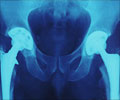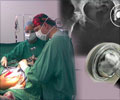What is Arthroplasty?
Arthroplasty is a surgical procedure that improves and revives the full functionality of the bone joints. Bones may be affected by arthritis, juvenile arthritis, injury, or a fracture. In 1880, Thermestocles Glock performed the first total joint arthroplasty. Arthroplasty of the existing bones involves reforming the bone structure or using artificial implants or prostheses. The artifical implants are made with materials, such as ceramics, metals, and polymers. These biomaterials are compatible with human cells and body tissues. Hip replacement surgery, knee replacement (total, patellofemoral, partial, or medial), shoulder replacement (total, reverse total, resurfacing hemiarthroplasty, stemmed arthroplasty), elbow replacement, or wrist replacement surgery are different forms of arthroplasty. Hip replacement surgery and total knee replacement surgery are among the most successful surgeries in medicine. The costs of the procedure is ~ $13 000 in the United States and ~ $6000 in Canada. In India, the cost for knee arthroplasty is ~ $6500.
![Arthroplasty Arthroplasty]()
Reasons for Performing Arthroplasty
Arthritis leads to joint complications. There is a deterioration in the cartilage, new bone formation, and thickening of the subchondral bone surrounding the joints leading to osteoarthritis. Prior to arthroplasty, other forms of treatment and medications are recommended to reduce the pain. These forms of treatment, include pain medications, anti-inflammatory medications, weight loss, glucosamine and chondroitin sulphate medications, cortisone injections, exercise, physiotherapy, realignment of the bone, regeneration of the cartilage, and avoiding painful activities.
Arthroplasty is performed for joint complications arising from osteoarthritis, injury, or fracture of the knee, hip, shoulder, wrist, or elbow. When medications and other pain-relieving treatments do not work, arthroplasty is recommended for total joint replacement. For example, in the case of patellofemoral joint arthritis, arthroplasty is recommended. Unicompartmental medial knee osteoarthritis is treated by unicompartmental or unicondylar knee arthroplasty. Total knee arthritis is treated with total knee arthroplasty.
Surgical Procedure of Arthroplasty
Arthroplasty is performed in outpatient clinics and hospitals. The damaged bone and cartilage is removed and replaced with the artificial implants (eg, ceramic, metal, and plastic). These implants perform the original function of the replaced bone. A spacer is placed between the metal implants to prevent them from rubbing against each other.
Computer-assisted surgery, patella-treated surgery, patient-specific surgery, and cemented procedures are some of the surgical techniques to perform knee arthroplasty.
In the procedure leading up to arthroplasty, the patient is informed of the procedure by the doctor. The doctor mentions the risks and complications involved in the procedure. The patient is advised to consider the information and make a decision. The patient is then required to fill out a consent form to provide permission for the procedure. The patientís medical history is taken. In addition, blood tests and other diagnostic tests are performed. The patient needs to inform the doctor of any allergies, pre-existing disease conditions, pregnancy, and medications being taken.
The patient is asked to fast for eight hours after midnight before the surgery. A physiotherapist meets with the patient to discuss rehabilitation procedures following the surgery. The surgery may be performed under general or local anesthesia. The patient is required to wear a hospital gown and is given an intravenous (IV) line in the hand or arm. The patient is attached to a urinary catheter and is laid on an operating table. Hair is removed from the surgery site. Antispetic solution is used to clean the surgical site before the surgeon makes an incision. The affected bone is removed and replaced with an implant. The bone is resurfaced and a metal spacer is placed between the implants to prevent them from rubbing against each other. The site is then closed with stitches or staples. A sterile dressing or bandage covers the surgical site. The total time of the procedure takes a few hours depending on the region being operated upon. The patient is required to stay several days in the hospital.
Risks and Complications Associated with Arthroplasty
Arthroplasty is associated with the following risks:
- Injury to nerves
- Displacement of implants or prosthetic joints: Misalignment, intraoperative fractures, or fractures post surgery.
- Deep venous thrombosis or pulmonary embolus
![Deep Venous Thrombosis Deep Venous Thrombosis]()
- Infection at the site of surgery: A recent report has observed that low hemoglobin levels (<10 mg/dL) prior to surgery is a risk factor for infections post surgery. The male sex, revision knee arthroplasty, revision surgery are also risk factors for infections at the surgical site.
- Bleeding
- No reduction in joint pain: Anterior knee pain
- Bone deficiencies: Although materials, like metal wedges, cement, allografts are utilized to stabilize the surrounding ligaments and the bone-implant interface, sometimes the alignment is not perfect after surgery.
- Aseptic loosening: Debris from the implants may break free and initiate immunological responses.
- Patient satisfaction: Patients need to be well informed of the risks and complications involved in arthroplasty. The time frame of recovery and the duration of the decrease in pain intensity need to be clearly outlined. Patient expectations may decrease if they are not well informed.
Doctors inform their patients of the risks involved in the surgery and the complications that follow from the surgery.
Recovery
Patients recover at different rates following the surgery. Patients experience pain at the site of the new prosthetic implant. The surrounding muscles are stiff due to inactivity and as they adjust to the new inserted implant.
Patients are advised to begin moving their new joint immediately following the surgery using support devices like a walking stick. Exercises help strengthen the joint and the surrounding muscles. The doctor or the physiotherapist will demonstrate the exercises required to be performed. Physical therapy is required for 4 to 6 months.
Designs of Implants
There are different designs of implants utilized for arthroplasty. In total knee arthroplasty, fixed, mobile, gender-specific devices (narrow femoral component design), high-flexion devices, posterior cruciate ligament retention devices, and constrained devices are some of the implant designs.
In total hip replacement, the materials used in the implants consist of a combination of polyethylene, cobalt-chrome alloy, polymethylmethacrylate (bone cement), and titanium.
Implants for shoulder, elbow, wrist, and intervertebral discs are in various phases of technology development.
Health Tips
The patient needs to report any complications, such as dizziness, fever, increased pain, shortness of breath to the doctor following the surgery. Modifications at home, such as handrails in the shower or on the stairs, elevated toilet seat, and a stick to reach objects are effective in improving the lifestyle of the patient post surgery. A balanced diet with iron supplements are also recommended.













